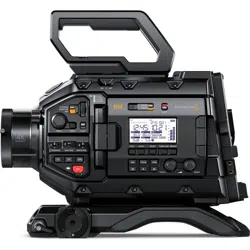Loading ...
Loading ...
Loading ...

Inserting an SSD
To insert an SSD:
1 Hold your SSD with the connection pins facing towards the front of your camera.
2 Open the spring loaded cover on Blackmagic URSA Mini Recorder and gently insert the
SSDintothe slot.
TIP Blackmagic URSA Mini Recorder has a pressure plate to keep different
sized SSDs in place, so there’s no need to use spacers to fit your drive.
3 Once your SSD is all the way into the slot gently push it home until you feel it register,
then lower URSA Mini Recorder’s cover.
4 The SSD will occupy the third media slot on your camera.
5 To switch recording to the SSD, press and hold the drive name in the lower toolbar
of your camera’s LCD display. The media bar will turn blue to indicate that the camera
will now be recording to the SSD. When recording the media bar will turn red.
To remove an SSD:
Open URSA Mini Recorder’s cover and gently grasp the drive between your thumb and
forefinger. There’s a small recess in the top of the bay to let you get a grip on the drive.
Simply pull the drive out and close the cover.
Choosing a fast SSD for URSA Mini Recorder
SSDs are designed to offer fast, affordable storage for a wide range of devices. It’s important
to note that film making is only one part of the SSD market, so choosing the right drive is vital
to ensuring that you have enough bandwidth to record Blackmagic RAW or Ultra HD footage.
ManySSDs are designed for home computing and aren’t fast enough to record Ultra HD video.
We highly recommend using only the SSDs from our recommended list, which have been tested
with Blackmagic URSA Broadcast G2 to ensure support for continuous filming at the specified
resolutions. For the most up to date list of recommended SSDs please go to
www.blackmagicdesign.com/support
Important Notes About SSD Speed
Some models of SSD can’t save video data at the speed the manufacturer claims.
Thisis due to the disk using hidden data compression to attain higher write speeds.
This data compression can only save data at the manufacturer’s claimed speed when
storing data such as blank data or simple files. Video data includes video noise and
pixels which are more random so compression will not help, therefore revealing the
true speed of the disk.
Some SSDs can have up to 50% lower write speed than the manufacturer’s claimed speed.
Even though the disk specifications claim an SSD has speeds fast enough to handle video,
in reality the disk isn’t fast enough when used to store video data for real time capture.
Use Blackmagic Disk Speed Test to accurately measure whether your SSD will be able
to handle high data rate video capture and playback. Blackmagic Disk Speed Test
uses data to simulate the storage of video so you get results similar to what you’ll see
when capturing video to a disk. During Blackmagic’s rigorous testing, we have found
newer, larger models of SSD and larger capacity SSDs are generally faster.
23Storage Media
Loading ...
Loading ...
Loading ...
